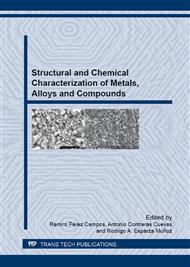[1]
T.B. Massalski, H. Okamoto and ASM International: Binary Alloy Phase Diagrams ASM International (1990).
Google Scholar
[2]
L. S. J. Peng, G. S. Collins, Point defects and the B2 to FCC transformation in milled FeRh, Mat. Res. Soc. Symp. Proc. 481 (1998) 631.
DOI: 10.1557/proc-481-631
Google Scholar
[3]
S. Scudino, M. Sakaliyska, K.B. Surreddi, J. Eckert, Mechanical alloying and milling of Al-Mg alloys, Journal of Alloys and Compounds 483 (2009) 2-7.
DOI: 10.1016/j.jallcom.2008.07.161
Google Scholar
[4]
G. S. Collins and P. Sinha, Atomic defects and disorder in mechanically-milled intermetallic compounds, Materials Science Forum 275 (1996) 225-227.
DOI: 10.4028/www.scientific.net/msf.225-227.275
Google Scholar
[5]
L. S. J. Peng and G. S. Collins, Disordering of FeAl by Mechanical Milling, Materials Science Forum 537 (1997) 235-238.
DOI: 10.4028/www.scientific.net/msf.235-238.535
Google Scholar
[6]
S. V. Starenchenko and V. A. Starenchenko, Special features of the deformation-induced order-disorder phase transition and its modeling, Russian Physics Journal 49 (2006) 5-23.
DOI: 10.1007/s00000-006-0065-5
Google Scholar
[7]
S. Shukla, A. Banas, R.V. Ramanujan, Atomistic mechanism of cyclic phase transitions in Nd–Fe–B based intermetallics, Intermetallics 19 (2011) 1265-1273.
DOI: 10.1016/j.intermet.2011.04.006
Google Scholar
[8]
C. Suryanarayana, Mechanical alloying and milling, Progress in Materials Science 46 (2001) 1-184.
Google Scholar
[9]
M. Sherif El-Eskandarany and A. Inoue, Mechanically induced cyclic metastable phase transformations of Zr2Ni alloys, Physical Review B 75 (2007) 224109.
Google Scholar
[10]
S. M. Cotes, A. F. Cabrera, L. C. Damonte, R. C. Mercader and J. Desimoni, Phase Transformations in Fe–Mn Alloys Induced by Ball Milling, Hyperfine Interactions 141/142 (2002) 409-414.
DOI: 10.1023/a:1021204909505
Google Scholar
[11]
T. Kiseleva, A. Novakova, M. Zimina, S. Polyakov, E. Levin and T. Grigoryeva, Mechanochemically induced formation of amorphous phase at oxide nanocomposite interfaces, Journal of Physics: Conference Series 217 (2010) 012106.
DOI: 10.1088/1742-6596/217/1/012106
Google Scholar
[12]
B. Tian, F. Chen, Y.X. Tong, L. Li, Y.F. Zheng, Y. Liu, Q.Z. Li, Phase transition of Ni–Mn–Ga alloy powders prepared by vibration ball milling, Journal of Alloys and Compounds 509 (2011) 4563-4568.
DOI: 10.1016/j.jallcom.2011.01.104
Google Scholar
[13]
L. Zhu, MA. Xue-Ming, L. Zhao, Study on phase transformation of Fe-Ni powders during mechanical alloying, Journal of Materials Science 36 (2001) 5571-5574.
Google Scholar


